BRIEF INFORMATION`S
ABOUT WORLD BEST TOURIST DESTINATION CENTURY
AWARD
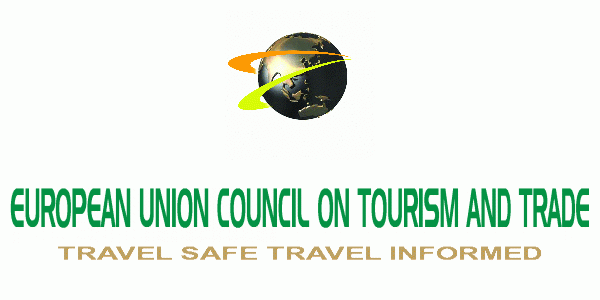
WORLD BEST TOURIST
DESTINATION AWARD
INFORMATION`S ABOUT WORLD
BEST TOURIST DESTINATION AWARD
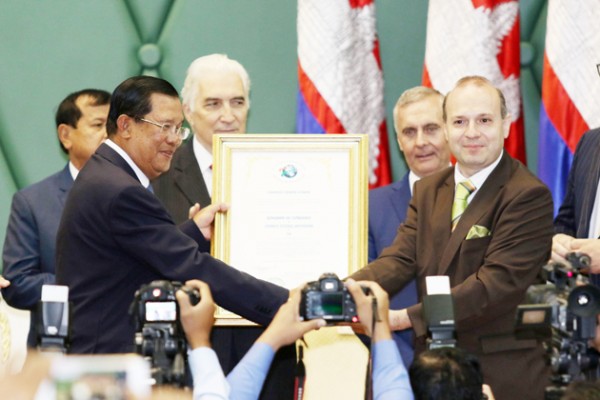

H.E.
Prime Minister of Cambodia-Samdech Akka Moha Sena Padei Techo-HUN SEN and
Government of Kingdom of Cambodia receiving WORLD BEST TOURIST DESTINATION
AWARD from European Council on Tourism
and Trade delegation lead by H.E. President Professor Dr. Anton Caragea (Phnom
Penh, June 2016).
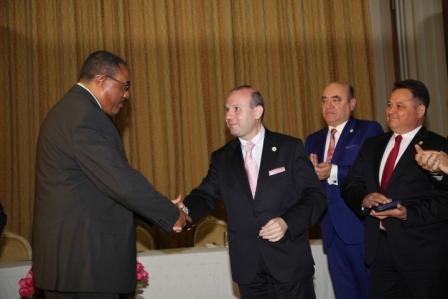

H.E.
Prime Minister of Federal Democratic Republic of Ethiopia Academician
Hailemariam Desalegn and Government of Ethiopia receiving WORLD BEST TOURIST DESTINATION
AWARD from European Council on Tourism
and Trade delegation (Addis Ababa, July 2015)

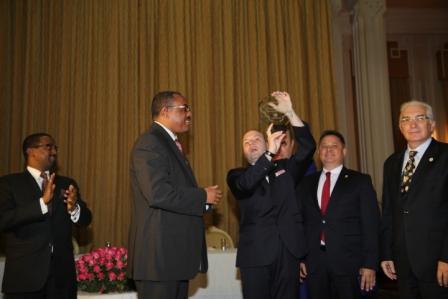
ETHIOPIA
IS WORLD BEST TOURIST DESTINATION FOR 2015!
H.E.
Prime Minister of Federal Democratic Republic of Ethiopia Academician Hailemariam Desalegn and
Government of Ethiopia receiving FAVORITE CULTURAL DESTINATION IN
2015 from European Council on Tourism and Trade President
Professor Dr. Anton Caragea
(Addis
Ababa, July 2015)
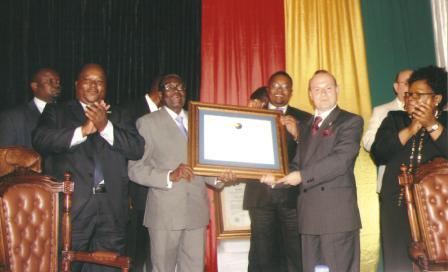
H.E. President of Zimbabwe Robert Gabriel Mugabe and Government of The Republic of Zimbabwe receiving
WORLD BEST TOURIST DESTINATION AWARD from European Council on Tourism and Trade delegation (Harare, June 2014)
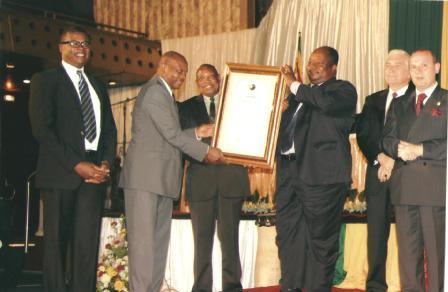
Government of Republic of Zimbabwe lead by Minister of Culture of Zimbabwe and Zimbabwe tourism Authority CEO-Karikoga Kasege receiving FAVORITE CULTURAL DESTINATION IN 2014 AWARD from European Council on Tourism and Trade delegation (Harare, June 2014)
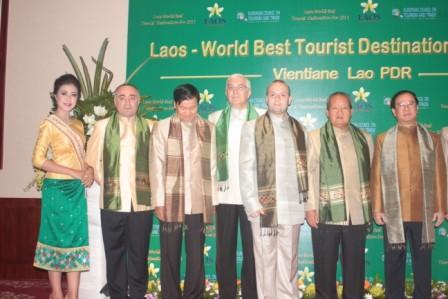
President of Lao PDR and
Government of Laos receiving WORLD BEST TOURIST DESTINATION AWARD from European
Council on Tourism and Trade delegation
( Vientiane , May 2013)
The WORLD BEST TOURIST DESTINATION is the highest
honor to be awarded for a country for achievements in tourism . This
award is offered to the countries that are complying with United Nations
Tourism Division , UNESCO and European Union Council on Tourism and Trade
(ECTT) principles on fair tourism, ethical tourism and safety standards and
historic preservation of cultural sites.
Historical background.
In 2006 a collective of international specialists in tourism ,
tourist education, tourism regulation experts and academics from European
Union member countries decided that the new century requires a special
prize dedicated to influence and support development of tourism in non European
Union countries , cultural tourism , historical sites preservation and to
direct tourism towards countries of social and cultural values.
On this occasion was decided the title and the methodology of
the WORLD BEST TOURIST DESTINATION AWARD.
According to 2006 decision of Board of European Union
Council on Tourism and Trade the Prize should be awarded under such
considerations as : This
award must be offered to the countries that are embracing tourism as a resource
for cultural and social development, who respect ethics of human relations and
preserve cultural and natural heritage as the receivers cities and
countries must prove their commitment towards sustainable development,
fair tourism and historical preservation . The title should act as a booster
for tourism in that place but in according with international tourism accepted
laws and regulation as decided by European Union Council on Tourism and Trade .
Among the reasons for awarding this title the Board should have
under consideration : the promotion of a free and fair tourism , safety of
tourists , facilities offered, access to historical and cultural significance
sites, the amount of investment in historical sites preservation, cultural
protection investment , use of tourism income for the creation of an economic
social balanced climate , historical value etc.
Nomination criteria and selection.
Every year the Academic Board of European Union Council on
Tourism and Trade specifically invites qualified tourism academics,
experts in tourism , European Union`s and world tourism policy
makers, personalities, former recipient of the award to
submit nominations for WORLD BEST TOURIST DESTINATION AWARD .
These nominators are selected each year by decision of Board of
European Union Council on Tourism and Trade :
- Members of
European Union`s Tourism Organizations and National tourism Organizations
from European Union
- Other members
of national parliaments and national governments of European union`s members
country`s
- Present
members of Board of European Union Council on Tourism and
Trade are ex officio participating
- Former members
of Board of European Union Council on Tourism and Trade
are participating by base to base invitation only
- University
professors from fields of history , tourism , international relations, from
European Union
- Important
international personalities form tourism environment.
Nominations are usually submitted until 1 of August of the year
in question but the update and new name are accepted until the completion is
closed. The statues of WORLD BEST TOURIST DESTINATION AWARD guarantee the
secrecy of nominations, procedure, considerations and investigation for a
period of 50 years after the prize have being awarded.
The nominations are not representing anything else than the
opinion of the nominators and are not involving the European Union Council on
Tourism and Trade in any way. Only the final public
decision is endorsed by the European Union Council on Tourism and Trade .
Selection.
Nominations are evaluated and consider on a year round basis by
the Academic Committee until a short list of candidates is created and
circulated. In the final stage each of the prior recipients of the award are
requested to offer their opinion on the short listed candidates in 20 days. The
decision is ideal if is a unanimous one but this is not always achievable so
the largest consensus will be the base for final decision. There is not
final date to announce the winner and no pressure on the committee in order to
insure that they just and correct decision was taken.
Awarding the WORLD BEST TOURIST DESTINATION AWARD.
The President of European Union Council on Tourism and Trade
presents the WORLD BEST TOURIST DESTINATION AWARD in the presence of a
delegation of European Union Council on Tourism and Trade in the
capital or city that is obtaining the status WORLD BEST TOURIST DESTINATION
AWARD.
The WORLD BEST TOURIST DESTINATION AWARD receives a diploma of
honor, a scroll certifying the authenticity of the title and a special trophy.
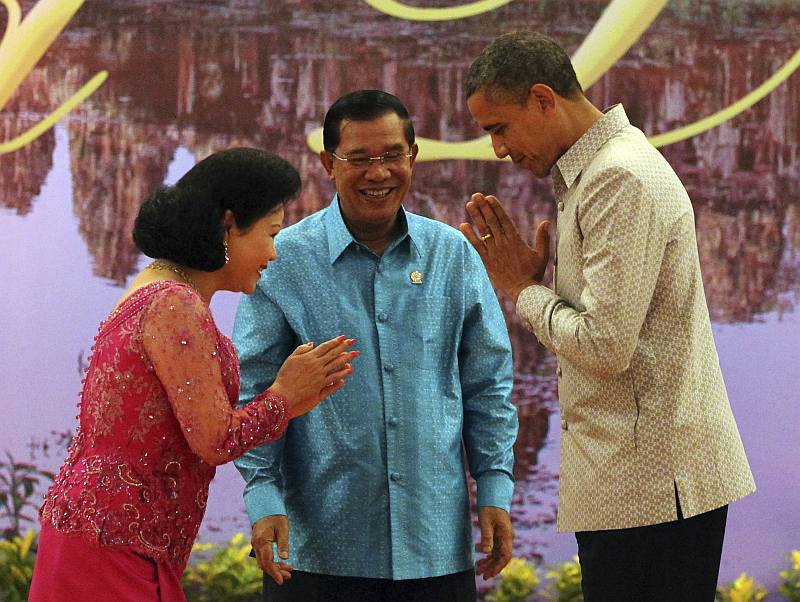
US President Barack Obama takes a bow in reverence to Academician Prime Minister of the Kingdom of Cambodia-HUN SEN and to World Tourism Ambassador of Cambodia Mrs. Bun Rany.
ACADEMICIAN
SAMDECH HUN SEN, PRIME MINISTER OF KINGDOM OF CAMBODIA, OPENING DECLARATION FOR
WORLD TOURISM AWARDS 2016.
Samdech Akka Moha Sena Padei Techo HUN SEN
Prime Minister of the Kingdom of Cambodia
At the
Celebration of Cambodia’s winning of World Best Tourist Destination
Award for 2016 and the Declaration of Cambodia as “a
Favorite Cultural Destination in 2016”

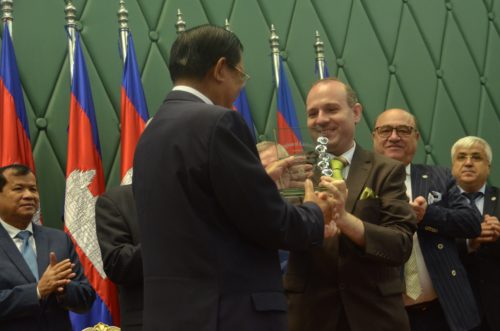
Academician Dr. HUN SEN, Prime Minister of Cambodia, surrounded with love
and respect on the platform of WORD BEST TOURIST DESTINATION CEREMONY for 2016.
Peace Palace, June 22, 2016
– H.E. Dr. Anton Caragea, President of European Council on Tourism and
Trade
– Distinguished National and International Guests!
Today, I am
delighted to participate in the ceremony to celebrate Cambodia being awarded “World Best Tourist Destination
2016 Award”and the Inauguration of “Cambodia as a Favorite Cultural
Destination in 2016”, along with the first Competition on “First Good
Hospitality”.
At the outset, I would like to extend a very warm welcome the delegation
of the European Council on Tourism and Trade to this event.
I would like to also express my gratitude and appreciation to H.E. Dr.
Anton Caragea, President of the European Council on Tourism and Trade and his
colleagues for creating this highly important award which will
help promote Cambodia tourism.
I also thank the European Council on Tourism and Trade for electing me as
an honorary member of the European Tourism Academy.
On behalf
of the Royal Government and People of Cambodia, I am really proud that the
Kingdom of Cambodia has been awarded the World Best Tourist Destination 2016
Award along with the declaration of “Cambodia as a Popular Cultural Destination in 2016”.

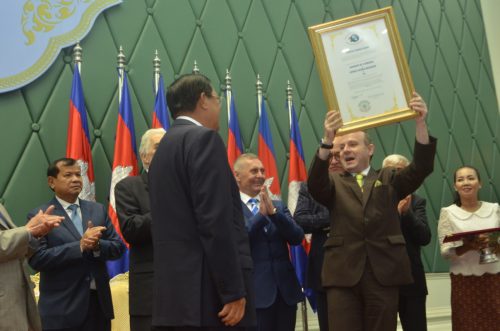
Prime Minister of Kingdom of Cambodia, Samdech Akka Moha Sena Padei Techo
HUN SEN is entrusted with CRISTAL TROPHY, signal of WORLD BEST TOURIST
DESTINATION AWARD for 2016 by H.E. Professor Dr. Anton Caragea, European
Council on Tourism and Trade President.
This result indeed attests to real situation of Cambodia and the wonder
of Cambodia as “Culture and Nature” tourist destination which is now a major
tourist destination in Asia and Southeast Asia, a region that is enjoying high
tourism growth thanks to richness of culture, history and nature.
Cambodia has indeed been playing a key role in connecting this regional
and highly attractive tourism network.
Overall, the temple of Angkor which is the heritage of humanity and the
wonder of the world, the temple of Preah Vihear which is of outstanding
universal value, the temple of Sambor Prei Kuk and thousands of other temples
within the country and vast natural resources along Cambodia’s Beaches that
have been awarded the world most beautiful beaches, Mekong River which has
freshwater dolphins, eco-tourism region in the northeastern and
southeastern Cambodia, Tonle Sap Lake, traditions and customs and the
friendliness of the people, couples with security and safety factors within the
country are the great magnet for tourists.
Those factors help Cambodia live up to its international recognition as
“Kingdom of Wonder”.

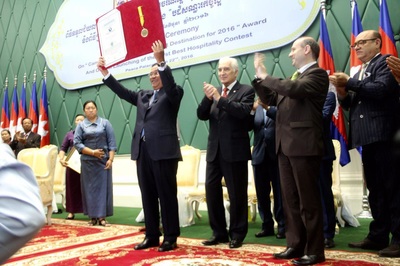
Academician Dr. HUN SEN raises the HONORARY ACADEMICIAN CERTIFICATEto
be observed by the audience of WORLD TOURISM AWARDS ceremonies.
As raised by H.E. Dr. Anton Caragea that Cambodia deserves the
reputation of “The Kingdom of Wonder” and this reputation has noticeably
contributed to the development of tourism sector in Cambodia within this last
two decades. In fact, the revenue that comes from tourism sector is a
significant contribution to Cambodia’s macroeconomic stability and
socio-economic progress and help promote the growth of some supporting
sectors such as agriculture, trade, infrastructure and SMEs.
Furthermore, the development of tourism sector has generated revenue that
support culture conservation and protection of environment and natural resource
in effective and responsible way.

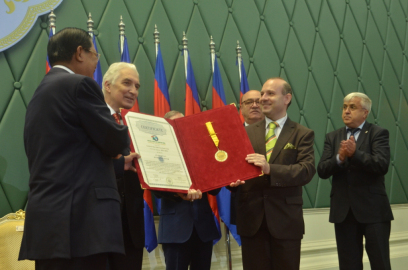
Prime Minister of Kingdom of Cambodia, Samdech Akka Moha Sena Padei Techo
HUN SEN delivers the enlighten declaration for WORLD TOURISM AWARDS ceremony in
2016.
With this spirit, Cambodia is committed to developing its tourism sector
in a sustainable, responsible and equitable manner that contributes to economic
growth and poverty reduction and responds to climate change.
This “Green Gold” will pay an important role in accomplishing the UN’s
sustainable development goals 2030.
On its part, Cambodia will be active and pro-active in grabbing
opportunities arising from its wonder as the world tourist destination.
This helps ensure not only socio-economic benefits, high income for
the people and sustainable development, but also the protection of
cultural and natural resources, in short “Cambodia’s wonder serves tourism,
tourism serves Cambodia’s wonder”.
Excellencies, Ladies, Gentlemen!
It is undeniable that although the government has strived hard as stated
above, the success of tourism sector would have never been achieved without
active participation from private sector and Cambodian people. In this regards,
we can say that this positive result is mainly attributed to our concerted
effort, unity and ownership.
Hence, to continue promoting tourism sector in Cambodia to become the
“World Best Tourist Destination” and “Tourist Destination with Warm
Hospitality”, on behalf of the Royal Government of Cambodia, I would like to
give some recommendations as follows:

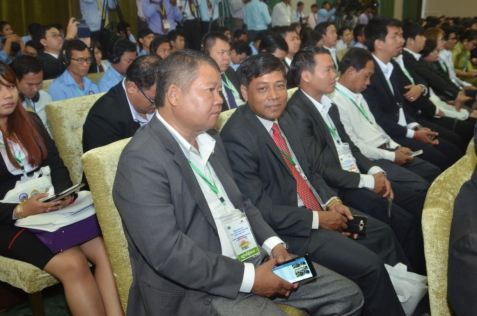
Business community pay attention, with pleasure, to the speech
of Prime Minister of Kingdom of Cambodia, Samdech Akka Moha Sena Padei
Techo HUN SEN.
Cambodia economy is booming and they are requested to add their intake.
1st. I am of the view that today’s success in tourism development,
especially Cambodia’s attractiveness proclaimed as the world‘s best tourist
destination rely on smiling and friendly faces of those at the front
ranging from flight services, international border checkpoints, accommodation,
food, entertainment and so on.
Therefore, the contest “Good Hospitality” is a new national agenda, and
we need to understand that “Hospitality is our obligation” and hospitality is
what we can do immediately with our requiring any means.
Furthermore, to make Cambodia the world
tourist destination that welcomes 7 million international tourists by 2020 and hosts SEA Game in 2023, I wish to
urge all the relevant parties to participate actively in the contest “Good
Hospitality”, including (1). Good hospitality in tourism services, (2). Good
hospitality in public service in clean city and (3). Good hospitality of
migration official at international border checkpoints.

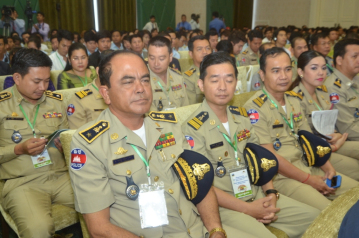
The proud army of Kingdom of Cambodia attending a peaceful victory
ceremony: Cambodia triumph of World Tourism Competition.
2nd. At this moment, I would like to
announce the campaign “Cambodia: Kingdom of Wonder” along with slogan
“providing warmth to tourists” to become a highly attractive advertisement to
the world as well as an important message to increase the number of returning
tourists to Cambodia.
In this regards, I request that relevant ministries and institutions pay
attention to protecting invaluable cultural and natural resources.

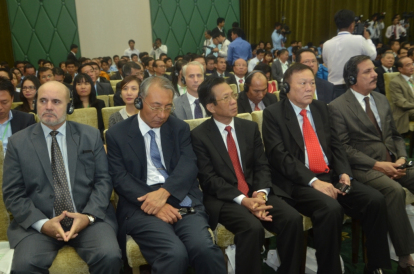
Furthermore, they also have to ensure that every
tourism-related development and construction in the
conservation, heritage and protected areas as well as coastal areas must comply
with the principles of sustainability, culture and tradition, and certain
regulation while responding to environmental and climate change issues.
4th. On top of the protection of natural and cultural resources together
with this friendliness, I suggest all relevant parties to continue their active
participation in the campaign “Clean Cambodia, Green Cambodia” by actively
supporting the movement contest “Clean City, Clean Resort, Good Service, Good
Hospitality”.
5th. To contribute to the promotion of tourism competitiveness in
Cambodia, the Ministry of Tourism must strive to cooperate with relevant
institutions to further develop creative and innovative tourist products and
create more package tours to make Cambodia become the “center of regional
tourism”.

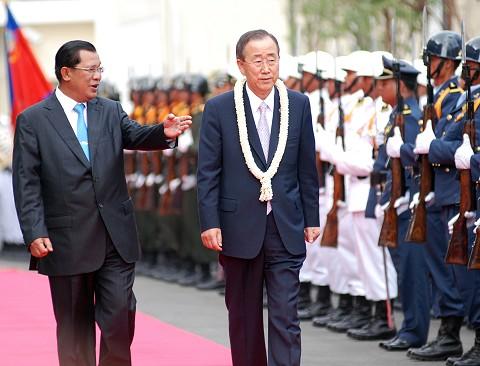
In this regard, I would like to request the European Council on Tourism
and Trade and private partners to continue supporting Cambodia in the
advertisement of tourism development and attract more European
and international investors and tourists to Cambodia.
6th. To transform Cambodia into the world’s tourist destination, it is
required to take into account the quality of tourism services and green
standard of each service, coupled with sufficient and skilled human resources.
In this
sense, I would like to request H.E. Professor Dr. Anton Caragea and H.E. Mircea Constantinescu,
Head of European Tourism Academy, to cooperate and support
Cambodia’s Ministry of Tourism to further study and develop tourism
standards, strengthen and develop human resources in tourism sector, as well as
to conduct tourism study and research more comprehensively while the sector
rapidly develops in globalization context.
Once again, I strongly believe that Cambodia, with this invaluable award,
would become a warm and attractive tourist destination with good welfare
provided to tourists and people.

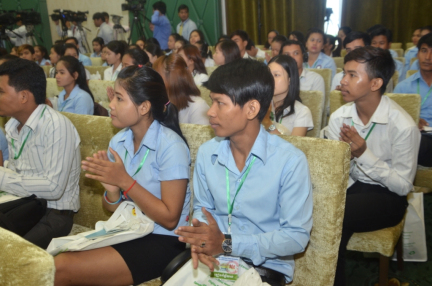
The youth of Cambodia are at the center of Prime Minister of Kingdom
of Cambodia, Samdech Akka Moha Sena Padei Techo HUN SEN policies and vision.
WORLD BEST TOURISM DESTINATION status is an achievement for their future.
Moreover, it would also become an attractive green tourist
destination with friendly and smiling faces, which can be named as “Cambodia:
the Kingdom of Smiles”, and this helps raise Cambodia’s reputation and prestige
as “Cambodia: Kingdom of Wonder” in international arena.
Finally,
along with the award celebration of “Cambodia: the World’s Best Tourist
Destination for 2016”, coupled with the announcement of “Cambodia: Favorite
Cultural Destination for 2016” and the movement contest of “First Good
Hospitality”, I wish H.E. Professor Dr. Anton
Caragea and senior delegation of the European Council on Tourism and Trade happiness, prosperity and success in
every undertaking.

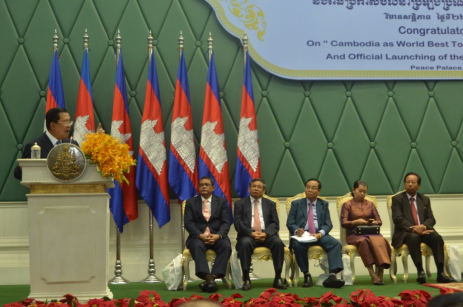
Prime Minister of Kingdom of Cambodia, Samdech Akka Moha Sena Padei Techo
HUN SEN, World Tourism and Development Leader, is marking the opening of WORLD
TOURISM AWARDS ceremonies for 2016.
At the same time, I also wish Excellencies, ladies, gentlemen and all
participants the four gems of Buddha’s blessings: Longevity, Nobility, Health
and Strength
H.E.
Prime Minister of Ethiopia- Academician Hailemariam Desalegn
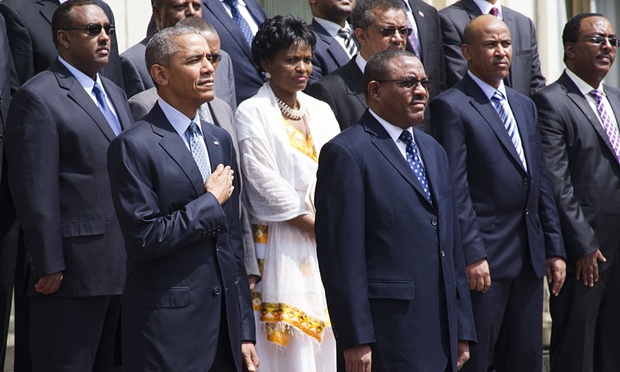

“This grant further motivates Ethiopia to offer more noteworthy
social and vacation destinations and administrations to sightseers over the
world,” PM Hailemariam said subsequent to accepting the grant.
The legislature of Ethiopia is resolved to ensure and safeguard
authentic and social legacies and “we trust it is in this acknowledgment of
this one of a kind game plan in addition to other things that ECTT chose to
stretch out to Ethiopia the world best traveler destination recompense.”
The stream of vacationers to Ethiopia has developed altogether
amid the most recent decade as the nation had the capacity give better
administrations that urged travelers to invest longer energy and investigate
Ethiopia’s surprising and wonderful attractions, he said.
Ethiopia will keep on developing the tourism area and utilization
it as a methods for political participation with different nations, he said.
Prime Minister Hailemariam Desalegn accepted for him the honorary
membership of European Tourism Academy insignia and on behalf of people of Ethiopia
accepted the diploma and the globe as official signs of World Best Tourist
Destination and Favorite Cultural Destination designation.
The world tourism ceremony for 2015 was organized by Minister of
Culture and Tourism of Ethiopia and by European Council on Tourism and Trade.
H.E. President of Zimbabwe and
African liberation hero-Robert Gabriel Mugabe
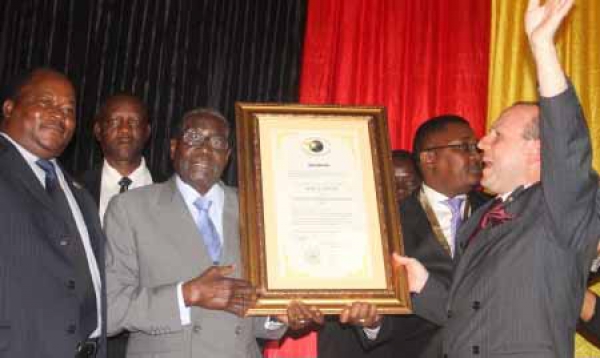

On the venue of WORLD BEST TOURIST DESTINATION award ceremony held
in Harare H.E. President of the Republic of Zimbabwe-Robert Gabriel Mugabe, the
african liberation hero, has presented the official acceptance allocution on
behalf of people and government of Zimbabwe.
Here is the full text of the inspiring speech presented by the
most famous african leader of today:
I want I thank for this event to: The Honorable Vice-President
Joice Mujuru
The Speaker of the House of Assembly and advocate Jacob Mudenda,
The Minister of Tourism and Hospitality Industry comrade Walter
Mzembi and all ministers here present,
Foremost to The President of European Council on Tourism and
Trade, Professor Dr. Anton Caragea and all members of his delegation, Minister
of Culture Andrew Langa , traditional leaders, all minister here presence, Members
of the diplomatic core,
Ladies and gentlemen`s, dear comrades,
I'm pleased though not surprised at all that the European Council
on Tourism and Trade had seen fit to give the awards for the BEST TOURIST
DESTINATION for 2014 and the distinction for FAVORITE CULTURAL DESTINTION for
2014 to Zimbabwe.
Zimbabwe's is indeed endowed with bountiful natural resources and
rich cultural history.
In addition our country is adjudged by relevant experts to poses
the best climate in the word making it: an attracting tourism destination all
year around
All thou like anyone else
we can experience dramatic climate conditions, the impact on us is not that
devastating , Zimbabwe can conform his reputation as an ideal tourism
destination, but destinations might be mere geographical entities, it have to
be destinations with people, and it is the people that are making destination
to worth the talk, and is therefore the people of Zimbabwe we should be praised
for the destination to be as warm as is proofed to be, Zimbabwe together with
many other countries in southern Africa has succeeded to preserved much of his
natural biodiversity in both flora and fauna, indeed we are home to some of the
Of the most sought after and rare animals in the world, including
the big five: the elephant- huge, the lion- feroces, the rhino-quiet, but
harmful, the leopard-there is stealthy but also blood thirsty and buffalo.
Of all this, the one we say is the most friendly maybe the
buffalo, it is the only one of them but it is just one but the others do not
provide the thing that we want to eat. I don’t know if the lion is eatable,
less still do I know if the rhino or leopard are eatable anywhere but the
elephant is, I did not tasted before I was in the prison where they serve us
with elephant meet, it but I can tell you that I never like it I never tasted
it after prison. I was afraid and who could not be afraid to eat the elephant ?
Who would obviously not be frighten to eat the elephant?
I am indeed proud that the iconic physical tourist attraction that
we have in the country that include: Victoria Falls, the Eastern Highlands, the
Mana Pools and off course the Exfoliated Hills in Manicaland, all must have
influence the European Council on Tourism and Trade to select out of 27
nominated country to select Zimbabwe as the winner of the BEST DESTINATION
AWARD.
It is our capacity to give tourists from all the corners of the
world access to all our country natural features, the opportunity for tourists
to explore nature in his ecological environment, must have strongly contributed
to ECTT decision to grant us the awards that we just received today.
Ladies and Gentleman’s
While our country rich historical and cultural legacy has caught
the et ye of ECTT, the venerable Great Zimbabwe, a fortified palatial complex
that must have being build in 12 century, must played his part , the Great
Zimbabwe from whom our great country is deriving his name is offering a rare
insight into one of the greatest pre-colonial civilization of Africa and indeed
a rare window into centuries of traditions.
Indeed countrymen, the winning of this award should must be a
wakeup call to many, to realize the many historical treasures that we own.
How many of us are aware of the many historical treasure that we
own ?
How many are aware that our national monuments in Manicaland are
dating back from stone age period ?
Many of this natural sites, that are now on the list of UNESCO
human heritage site, can and should be leveraged, to attract international
visitors to Zimbabwe
I believe is equally important for our people both children and
adults to know and visit this site, yes we can share them with world and can be
said that that we hold them entrust for humanity , but they remain first and
foremost our own, they defined our zimbabweness cultural diversity.
Cultural diversity in way of life and way of life showing itself
in our interaction, marriages but much, much more pleasantly in song and dance
and you heard today that diversity coming out from Reverend Damasani poetic
rendering.
A gifted man indeed!
O gifted musician, but a gifted moralist, man of prayer, man of
God,
We need to be thoroughly familiar with them and be proud with
them. Some time I think that Zimbabweans are not knowing their country
endowment, beside mineral gold, and precious stones, perhaps Ministry of
Tourism and Hospitality should launch a know your Zimbabwe! , know yourself
campaign!
To facilitate, to know our country.
I must pay a tribute to this young person they call Minister
Mzembi, now the only surviving minister of tourism in Africa, or in the world,
so he says
I rate him as one of my best ministers.
Foresight, full of brilliant ideas that are not remaining just in
the mind, they take the form of action and practice.
Yes, he has gallivanted the world: East, West, North South, but
every step he took, was to make better know Zimbabwe, two make the people
better know, to make the reaches of Zimbabwe better known.
We still have so many not unknown, some of them where known and
dig out, but thanks God we still have them and we start to discovering them for
ourselves.
Let the world to know us and to know us fully: that we are a
peaceful people but a proud people as well, and when it comes about natural
resources s committed to be their owners, jealous of them.
Fighters against
imperialism and colonialism because it wants to displace us, as in deed they
have displaced us for nearly a century, and we are owners and in possession of
our wealth.
A wealth that we discovered !
Even our past was sometime ugly, difficult for our ancestors, but
let it be know our immediate past even as well as our contemporary history.
Is in this context that we emphasize the importance of our history
of liberating Zimbabwe from colonial bondage and it is in this context that we
want to emphasize the importance of writing the history because was not just
the liberation of the people but the liberation of a people and their resources
and their the tourist attraction as well.
Must people commemorate the major historical wars going back to
centuries, our war of liberation was, only yesterday, comparatively specking,
we should not risk erase it from our memories
But we should preserved our pride history
We won a great war the often pitted poorly armed, often shoeless
peasants against experienced, well armed, ruffles mercenaries, but we won it,
against all odds.
It was a people war, not just a ZANU ZAPU ZAMPLA ZIBRA war. No!
Those where fronts, fronts of the people of Zimbabwe in their
diversity and thus where fronts of determined people, determined to fight for
our people, their people, our people.
We should never forget our people together, whatever their
cultural believes religious, cultural, political, they are our people and hence
the need for the unity of our people, unity in diversity,
We need to enshrined all location of majors battles indeed and
grow them into iconic attractions, that our visitors and our posterity will
visit and value them for all time.
They become visiting places, tourist attraction.
They will naturally evoke
memories, but they should never, even if they made us angry sometimes, they
should never make us to want to fight again, but should make us to be always
ready against the enemy, against thus who want to pull the same trick already
that they put against us in 1890 lasting up to 1980 we say No. Never again!
Ladies and gentlemen, comrades and friends, President of the
European Council on Tourism and Trade.
Let me conclude by saying:
Thank you to you to European Council on Tourism and Trade-ECTT for
these awards.
We should thank you for your magnanimity, I say magnanimity
because at this juncture, during this time, at this time.
When others are thinking at punishing us more, you are thinking of
making us more a friend than enemy. We are thanking you; we are exuding with
friendship and love for others who equally may exude with love and friendship
to us.
It is that interaction of love, love of nations, and love of
people that we in Zimbabwe we want to work for.
Let me conclude by saying that I ‘am greatly enthusiastic and
appreciative and full of pride for all the decision taken by European Council
on Tourism and Trade (ECTT) to give this awards to Zimbabwe.
If the countries that have win these awards in the past are
anything to go by, the European Council on Tourism and Trade has a very
powerful and transparent desire to draw all the world's attention to the
tourism potential in developing countries
Thank you for that!
This award is having the effect of putting the winner under the
global limelight and I want to say that we have this limelight, thanks to the
European Council on Tourism and Trade (ECTT) and thanks to you the Zimbabweans
for demonstrating that you love others in the world.
We are now in the global
limelight!
I want to promise to the
European Council on Tourism and Trade that we shall continue to increase our
efforts to leverage the potential that you have identified in us and always
make Zimbabwe a preferred tourist destination in the world, a people loving
people’s destination.
And I want to assure you
that this is what are we working for: peace and harmony in Zimbabwe, peace and
harmony in the region, and peace and harmony in the world
I want to say once again
thank you to European Council on Tourism and Trade for these awards, we shell
treasure them for all time.
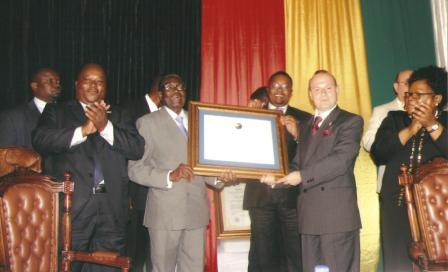
Honorable Kamla Pershad Bissessar –Prime Minister of Government of Republic of Trinidad and Tobago about
WORLD BEST TOURIST DESTINATION AWARD
The award of World’s Best Tourist Destination will significantly assist in branding destination Trinidad and Tobago globally. We must change the perception of our country in the overseas markets. We must celebrate our country and work hard to sell our country abroad. It is anticipated that this award will open us to untapped European markets that are perhaps weary of the traditional leisure destinations and desire a more exciting vacation experience.

Honorable Kamla Pershad Bissessar –Prime Minister of Government of Republic of Trinidad and Tobago
Date: Wednesday October 19, 2011
Venue: Regency 4, 5 &6 of Hyatt Regency Trinidad
Time: 12.30pm
I am indeed truly humbled and deeply honoured to be standing here today to accept, on behalf of the People of Trinidad and Tobago, the World’s Best Tourism Destination Award for 2012 from the European Union Council on Tourism and Trade. A non-governmental organisation, this body has a wide ranging membership of tourism representatives within the European Union.
We were also declared the World’s Favourite Cultural Destination in 2012 by the European Union Council on Tourism and Trade.
It is my understanding that this award was unanimously given to Trinidad and Tobago primarily for our history of impressive cultural festivals, environmental conservation and biodiversity protection amongst other factors.
It is not an award that is traditionally given to well-established tourism destinations but it is the highest honour awarded to non-European Union countries that have embraced sustainable tourism as a tool for cultural and social development and that respect and preserve their cultural and natural heritage.
I extend my heartfelt thanks to the European Union Council on Tourism and Trade for having us join other distinguished winners of this award such as the United Arab Emirates, Syria and South Koreea.
But moreover, I thank the Council for recognising what most of us fail to acknowledge and value. And this is … Trinidad and Tobago is brim-full with tourism potential.
We are not the traditional sun, sea and surf destination. What differentiates us from the rest of our Caribbean neighbours is our diverse and rich natural, cultural and built heritage.
This People’s Partnership Government is seriously committed and dedicated to the development of the tourism industry in Trinidad and Tobago. Tourism is an incredibly important pillar in our national economic diversification effort.
We are not paying “lip service” to the industry as some may have done in the past. For too long tourism has been looked down on as a second class service sector.
We recognise that tourism is a business and fiercely competitive. Tourism requires skills, talent, enterprise and more importantly the support of government.
The award of World’s Best Tourist Destination for 2012 is important for several reasons.
Firstly, it facilitates the formation of closer linkages with Europe for tourism, trade and investment possibilities. The European continent, as in its colonial past, is a formidable trading partner especially with the fall of communism and the rise of new economic powers.
Europe is, and will certainly continue to be, a cornerstone for our international business.
Ladies and gentlemen,
The economic and social advancement of this beautiful twin island Republic of ours depends to a large extent on how well we develop and harness our resources. And one such untapped resource is that of tourism.
The award of World’s Best Tourist Destination will significantly assist in branding destination Trinidad and Tobago globally. We must change the perception of our country in the overseas markets. We must celebrate our country and work hard to sell our country abroad.
It is anticipated that this award will open us to untapped European markets that are perhaps weary of the traditional leisure destinations and desire a more exciting vacation experience.
Ladies and Gentlemen,
An important opportunity that this award presents is a platform to advance the commitments of the Economic Partnership Agreement (EPA).
As many of you may or may not be aware, in 2008 Trinidad and Tobago, along with its neighbours in the rest of the region, embarked upon a reciprocal trade agreement with one of our largest trading partners – the European Union (EU). The signing of the EPA signalled a shift in our trade and economic development.
We are now required to open our markets to Eastern Union manufacturers and service providers; but the EPA also provides market access for our country’s export of services to the European Union.
The Economic Partnership Agreement also speaks to specific disciplines on tourism services because of its importance to the social and economic development of the European Union and the Caribbean. These rules are complemented by a commitment to legally binding open market conditions for each other. For instance, the Europe Union has made commitments for travel agencies, tour operators, tourist guides services.
Trinidad and Tobago, on the other hand, have made commitments in relation to hotels and restaurants, marina services and spa services.
The EPA also includes measures that would make it easier for European Union investors to invest in the Trinidad and Tobago. This award, then, will provide a platform to attract increased investment and to promote growth and development in the tourism sector.
The Economic Partnership Agreement is, therefore, rendered more relevant, more strategic and more focused on deliverables.

Honorable Prime Minister Kamla Pershad Bissessar receives WORLD BEST TOURIST DESTINATION AWARD for 2012.
The World’s Best Tourism Destination award will, moreover, engender a measure of national pride amongst our citizenry and raise the level of public confidence in Trinidad and Tobago as a tourist destination.
We should be proud of our country and its tourism potential. We have so much to be proud of, so much to share with each other, and so much to show off to the rest of the world. Let us not doubt or question our intrinsic value.
In closing, ladies and gentlemen, I must take a moment to publicly acknowledge the hard work and sacrifices of our tourism community … the stakeholders in our midst. The last few years have been quite challenging for all in the tourism industry.
But rest assured that the tourism industry will get the backing it needs.
But we cannot do it alone. We have all to work together. The private sector in the lead but with government acting as a facilitator; supporting every step of the way.
I want to urge you to continue working with commitment, energy and enthusiasm for the betterment of the tourism industry.
I thank you. God’s richest blessings on us all.
MINISTER OF CULTURE, INFORMATION AND TOURISM OF LAO PDR
ACADEMICIAN BOSENGKHAM VONGDARA KEY NOTE SPEECH AT WORLD BEST TOURIST
DESTINATION AWARD CEREMONY
Date: Thursday May 9, 2013
Venue: Lao PDR, Vientiane, Don Chan Palace Hotel
On behalf of the Lao government and people, it is my pleasure and delight to welcome all delegates to the presentation ceremony of the World's Best Tourist Destination Award for 2013 to Laos.
Today, the Lao government and people are proud and delighted to have received this honourable prize, which demonstrates the great achievements of tourism development in Laos. Laos offers impressive tourist attractions and services for tourists from across the world.

Minister of Culture, Information and Tourism of Lao PDR-Academician Professor dr. Bosengkham Vongdara and European Council on Tourism and Trade high ranking official`s delegation in Vientiane.
I would like to take this opportunity to praise and express my sincere gratitude to the European Council on Tourism and Trade and all tourists for highly valuing Lao tourism and selecting Laos as the World's Best Tourist Destination for 2013.
I would like, especially, to welcome Prof. Dr Anton Caragea, Chairman of the European Council on Tourism and Trade, and his delegation to Laos to attend the ceremony and present the award.
The Lao PDR is diverse in languages, cultures and customs, which have been inherited from our ancestors over thousands of years. The country is rich in spectacular natural resources as well as having a long and civilised history and well-known archaeological sites, which further boosts Laos' tourism potential.
With great effort and a high sense of responsibility by the Party and government since the 4th Party Congress in 1986 outlined a comprehensive renovation policy to open up for foreign cooperation, tourism has played an ever more prominent role in the country's socio-economic development.
The government has defined policy and taken action to develop and promote cultural, natural and historical tourism. To facilitate the growth of tourism and services, the government has done its utmost to develop infrastructure such as building roads to link all regions across the country as well as connecting with neighbouring countries. Over the past 4-5 years, the government has exerted utmost efforts to increase the number of border checkpoints to integrate with countries in the region and the world at large.
At present, the Lao PDR has 23 international checkpoints, of which 21 can issue visas. Laos has four international airports (Wattay International Airport, Luang Prabang International Airport, Savannakhet International Airport and Pakxe International Airport). Visas have been exempted for citizens of Asean member countries. Laos has also granted visa exemptions to citizens of Japan, Republic of Korea, Switzerland, Russia, Mongolia and Luxembourg.
The authorities have redefined that visas issued at checkpoints permit the holders to stay in Laos for 15 days, reduced from 30 days previously. According to Prime Ministerial Order No. 15 issued on June 20, 2006, these visas can be extended by the provincial authorities instead of only by the Vientiane authority as before. In addition, the government grants three-month visas to foreign citizens of Lao origin who acquire visas from Lao embassies, which can be extended for another three months.
However, visas issued at border checkpoints grant only a two-month stay with another two months of extension. After implementing the aforesaid tourism development and promotion policy, the tourism sec tor has grown rapidly. From 1990 to 2012, foreign tourist arrivals have risen by an average of 20.36 percent annually. In 2012, Laos registered 3,330,072 foreign tourists generating total revenue as high as US$513,576,784. By 2013 the number of tour operators had risen to 275 companies.
Hotels and guesthouses have also increased and in 2012 there were 3,526 hotels and guesthouses offering 35,857 rooms. Laos now has 1,493 official tourist sites comprising 849 sites of natural interest, 435 sites of cultural interest, and 209 historical sites.

Minister of Culture, Information and Tourism of Lao PDR-Academician Professor dr. Bosengkham Vongdara deleivering acceptance speech for LAOS: WORLD BEST TOURIST DESTINATION AWARD IN 2013.
The Lao PDR shares similar characteristics with many other countries, such as different and diverse traditions and customs among its multi-ethnic people.
There are also impressive archaeological and historical sites such as Luang Prabang, the historic town and living world heritage site, and Vat Phou Champassak, which is another world heritage site dating back to the 12th century. In addition, the historic caves of Viengxay (deemed to be the birthplace of the Lao PDR) have become an open-air museum, while the Plain of Jars is expected to be listed as a world heritage site in the near future. The Lao PDR also has rich and beautiful natural sites suitable for development as ecotourism attractions and green industry without smog or hazardous pollution, which will become new relaxing sites to impress visitors from the region and the world.
Community-based eco-tourism programmes have become Laos' unique feature and have great potential because they give visitors the chance to get in touch with and taste nat ure, as well as the everyday life of local people and the customs practised by the Lao multiethnic people.
To translate the tourism development strategic plan for 2011-2020, the Ministry of Information, Culture and Tourism in collaboration with provincial authorities have carried out nature-based tourism activities with the participation of local people by making use of the local potential and conditions of each province. Such activities were first initiated in 2000 in Luang Namtha province, called the ‘Community-based Eco-tourism Programme'. Similar programmes now exist in all 17 provinces involving 40 districts and 160 villages, and have generated income directly for local people.

Because of these progressive great achievements of the Lao tourism sector coupled with the impressive progress made in socio-economic development across the country, Laos has been praised by tourists and friendly countries across the world, justified by the fact that Laos has been awarded many honourable and impressive prizes as follows:
In 2008, the New York Times named Laos as one of 53 countries it described as the world's top tourist destinations.
The world heritage site of Luang Prabang received the Top City Gold Award after being voted the world's top tourist destination by Wanderlust, a UK based travel magazine from 2006 to 2008, and again from 2010 to 2012.
The Community-based Eco-tourism Programme in the Nam Ha Protected Forest Area in Luang Namtha province also won an award for ‘best poverty alleviation project' and ‘best services' given by the United Nations Development Programme. And today, we feel proud and honoured that the European Council on Tourism and Trade awards Laos with the World's Best Tourist Destination Award for 2013. This honourable prize will make Laos even more popular among tourists across the globe, and will drive the development of the tourism sector in our country.
I would like to take this opportunity to express my heartfelt thanks to Professor Dr Anton Caragea, President of the European Council on Tourism and Trade, for highly valuing the development of Lao tourism. I agree with his comment that “In the 21st century, tourism has become an important bridge for friendship and relations among nations in the world; it is also a way to promote peace and mutual understanding and lead the way to a good future.”
The Lao PDR stands ready to continue to develop the tourism sector to contribute to establishing and enhancing friendly relations among nations in the world to make a joint effort to promote peace and mutual understanding, together entering into the proper future of development under the sky of peace, friendship and sustainable cooperation.
On this auspicious occasion, I would like to wish Party and state leaders and honourable Lao and foreign guests participating in this ceremony good health, success in your noble tasks, happiness and prosperity, and further contributions to the tourism development of our country for progressive success.
I would like, especially, to wish Professor Dr Anton Caragea and high-level delegates from the European Council on Tourism and Trade good health, success in your noble tasks and happiness, and to further contribute to promoting Lao tourism in Europe and across the globe.




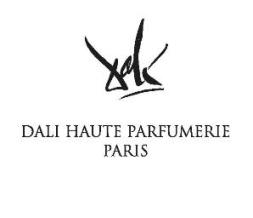

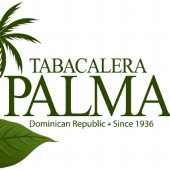

































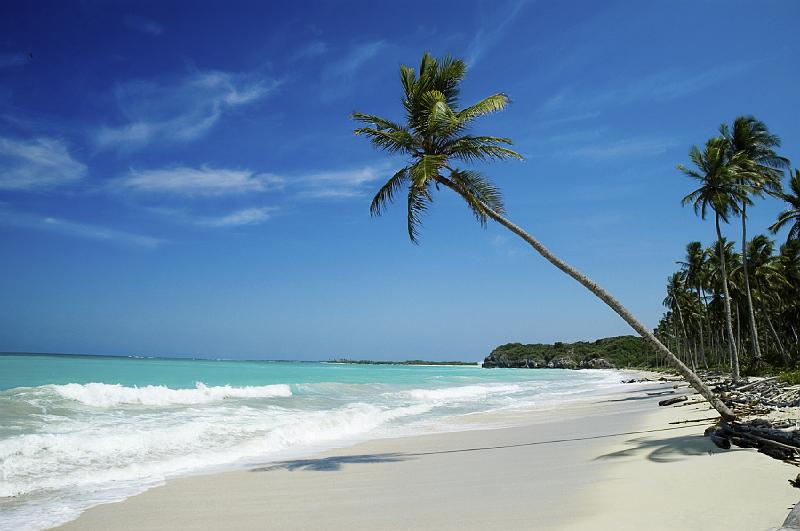
-web.jpg?timestamp=1484416305806)